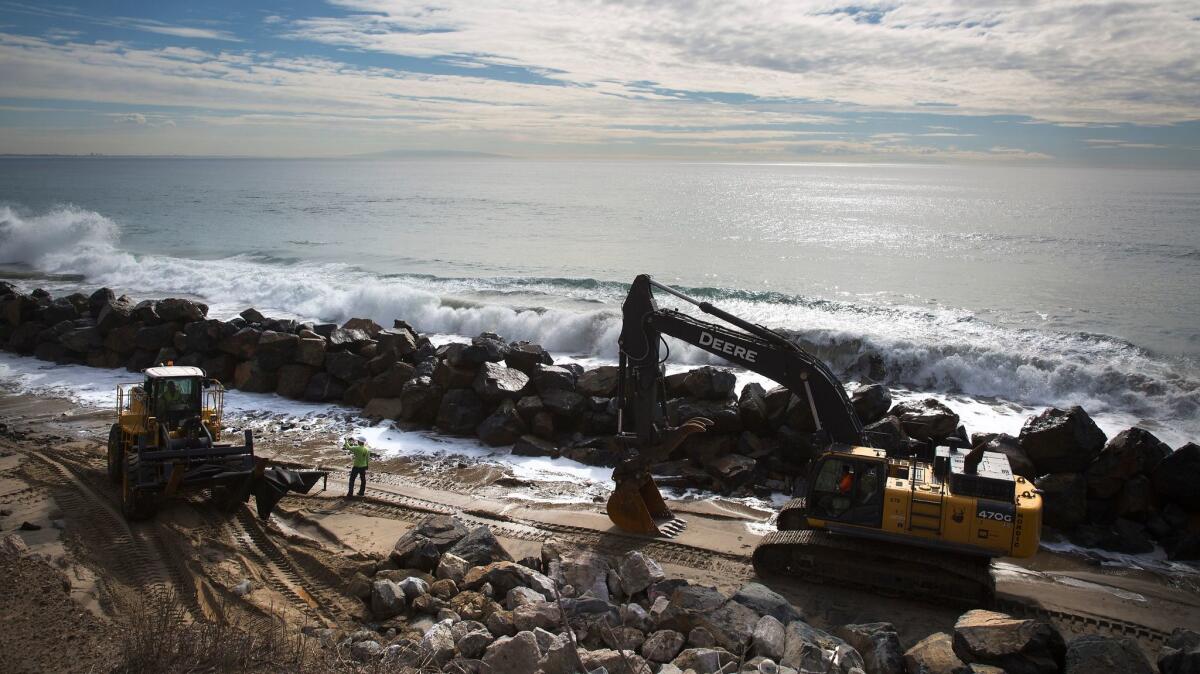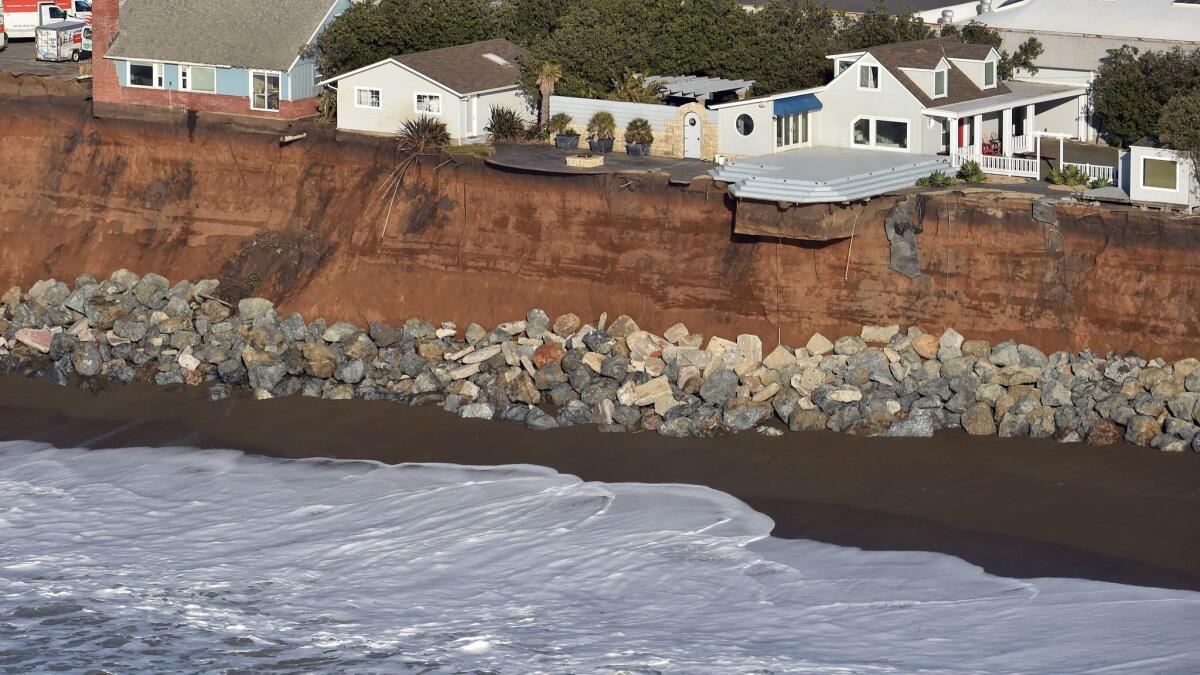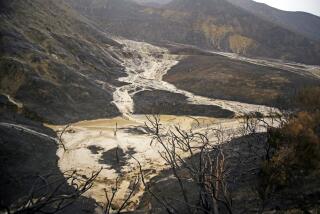El Niño triggered unprecedented erosion across Californiaâs coast

A new study suggests the weather pattern accelerates coastal erosion
El Niño may not have brought much rain to Southern California, but it did take its toll on the Golden Stateâs beaches.
A new study of the waves, water levels and coastal changes at 29 beaches across California, Oregon and Washington has found that the 2015-16 El Niño triggered unprecedented erosion across much of the West Coast.
The results, published this week in the journal Nature Communications, document a level of degradation from which these natural systems may not be able to recover. That could have far-reaching environmental and economic impacts, experts said.
The analysis also opens a window into how the coast is likely to hold up as climate change and its associated sea-level rise worsen.
âThis is likely the kind of El Niño we may experience more in the future,â said lead author Patrick Barnard, a coastal geologist with the U.S. Geological Survey in Santa Cruz.
El Niño is a multiyear weather pattern that typically brings big storms to the West Coast. Drought-parched Southern California had awaited the expected rains last winter with bated breath, hoping it would help revive Californiaâs wilting landscape. Northern California did get a good soaking â but down south, the deluge never materialized, leaving many Angelenos wondering whether El Niño really came to the region at all.
But the phenomenon did hit Southern California â along with the rest of the West Coast â hard. Thatâs because the weather pattern isnât just about rain. Its strength also can be measured by the power of the waves pounding the coastline.
Barnard knew he wasnât the only one watching the coastlines; colleagues at half a dozen other institutions had been monitoring activity along the West Coast. They quickly realized that, wet or not, they could have a monster El Niño on their hands â and that it could take a major toll on beaches.
Beaches go through a seasonal cycle: Powerful winter waves drag sand out to sea, while more gentle waves in the summer deposit much of that sand back onshore. During El Niño winters, the waves are extra-strong, removing even more sand â and causing more erosion â than usual.

Teaming up, the scientists made surface maps using a remote-sensing laser technology called light detection and ranging, or LIDAR. They also drove all-terrain vehicles across beaches to perform GPS-based topographic surveys. (Barnard, not the biggest fan of dune buggies, said he took it slow.) That kind of analysis wasnât possible during the last really big El Niño season in 1997-98, when GPS technology was just coming online, Barnard said.
âThere was a little bit of data collection back then,â he added, âbut now itâs basically cheaper, itâs faster â itâs easier to collect these kinds of data.â
The researchers found that the most extreme waves were about 50% larger than usual during the 2015-16 El Niño season. Consequently, the level of beach erosion was a whopping 76% higher than normal â and 27% higher than any other recorded winter.
Barnard and his colleagues had expected this El Niño would be big. They just hadnât thought it would be quite this big.
âWe saw the conditions in the Pacific, but I think we were definitely surprised at the scale of the event â especially in relation to the other two monster El Niños that have always been considered to be the big ones,â he said, referring to the 1982-83 and 1997-98 winter seasons.

The problem with such extreme erosion is that thereâs very little chance the summertime waves can deposit enough sand to make up the loss. That makes an El Niño like last yearâs a potentially unrecoverable event for the natural system.
Beaches can also be replenished with new sediment washing down rain-swollen rivers. But in Southern California, the combination of powerful waves and little rain created a worst-case scenario, Barnard said.
This situation is one thatâs been long in the making, said Robert Guza, a physical oceanographer at UC San Diegoâs Scripps Institution of Oceanography who was not involved in the study.
âSouthern California, we love to build in river floodplains and then say, âHoly crap, it flooded,ââ Guza said. âThen we dam the rivers for flood control and say, âHoly crap, the sandâs not getting to the beaches anymore.ââ
The damming of Southern Californiaâs rivers has trapped roughly half of the sediment that would otherwise replenish the regionâs beaches, he added â sediment that later costs money to remove.
âOur beaches are sand-starved, partially because weâre starving them,â he added.
The loss of such beach area has serious consequences for the plants and animals that rely on that habitat, said Lesley Ewing, a senior coastal engineer with the California Coastal Commission in San Francisco who was not involved in the research paper.
âThere are birds that nest on sandy beach areas; there are fish that lay their eggs on the beach, like grunion,â Ewing said. âSo theyâre really important for a number of parts of the food web.â
There are also economic ramifications for property owners and cities near such coveted shorelines. Beaches bring in money from both locals and tourists â which is why millions of dollars are often spent to bring in sand to artificially replenish them, Guza said.
âThe beaches are really an incredibly valuable public resource,â Ewing said, pointing out that those cooling sea breezes may become increasingly valuable to state residents as inland areas heat up over the next several decades.
Ewing said the study affirmed what sheâd seen at beaches in Northern California, including severe erosion at Half Moon Bay and Pacifica State Beach. For Guza, the findings helped explain the significant erosion heâd seen at San Diego beaches.
This El Niño may have been a big one, but it may become âthe new normal,â Guza and Ewing said.
During El Niño, the sea level temporarily rises by several inches along the coast. Thatâs a good proxy for the sea level rise thatâs expected in the coming decades as rising temperatures melt polar ice reserves, Guza said.
âThe only real prediction I have is, it will get worse â a lot worse,â Guza said. âI just donât know how fast.â
Communities, he said, will have to decide whether to protect vulnerable beaches â perhaps by bringing in more sand, or building sea walls.
In the meantime, researchers say they plan to continue tracking the health of West Coast beaches.
âBecause these kinds of events are forecast to be more common in the future, itâs really important for us to capture these in great detail so we can get a better sense for what kinds of winters we may expect more often in the future,â Barnard said.
Follow @aminawrite on Twitter for more science news and âlikeâ Los Angeles Times Science & Health on Facebook.
MORE IN SCIENCE
Concerned about Trump, scientists are leaning into politics
As bee populations dwindle, robot bees may pick up some of their pollination slack
Using science to see which countries are following through on Paris climate change goals
UPDATES:
6:35 p.m.: The story was updated with additional comments from Patrick Barnard of the USGS, as well as comments from Robert Guza of the Scripps Institution of Oceanography and Lesley Ewing of the California Coastal Commission.
The story was originally published at 8 a.m.







